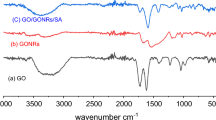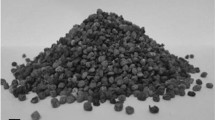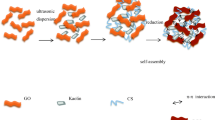Abstract
The toxic and the hazardous ramifications that affect both the environment and human beings due to the existence of uranium in wastewater are a huge challenge towards a sustainable environment. Uranium removal from wastewater is a big difficulty that is becoming more severe as the world’s population grows and energy demand rises. A hydrothermal and freeze-drying process is used to create a chitosan/graphene oxide/poly (vinyl alcohol) aerogel (CH/GO/PVA) for a very effective and selective uranium removal. Batch experiments were used to examine hexavalent uranium (VI) sorption from wastewater. The efficiency of U (VI) removal was investigated for time of contact, various pH, dosage of sorbent, initial concentration of U (VI), and temperature values. Field emission scanning electron microscopy, Fourier transform infrared spectroscopy, Energy Dispersive Spectroscopy, X-ray diffraction, and Brunauer-Emmett-Teller are utilized to describe the composition, morphology, polymer formation and nanocomposites. Kinetic and Freundlich equations, and the pseudo-second-order are used to illustrate the adsorption process. The adsorption capacity of U (VI) reaches its maximum of 1247 mg g–1 when an initial uranium concentration is 380 mg L–1, and the highest uranium removal efficiency is 98.44%. Thermodynamic study reveals an endothermic and spontaneous adsorption mechanism. Furthermore, the as-synthesized GO/CS/PVA aerogel has good mechanical as well as thermal stability, and can be utilized six times before losing a substantial portion of its original removing effectiveness.












Similar content being viewed by others
Data Availability
The datasets of the current study are available from the corresponding author on reasonable request.
References
W. Yao, X. Wang, Y. Liang, S. Yu, P. Gu, Y. Sun, et al. (2018). Synthesis of novel flower-like layered double oxides/carbon dots nanocomposites for U (VI) and 241Am (III) efficient removal: Batch and EXAFS studies. Chem. Eng. J. 332, 775–786. https://doi.org/10.1016/j.cej.2017.09.011.
Y. Sun and Y. Li (2021). Application of surface complexation modeling on adsorption of uranium at water-solid interface: A review. Environ. Pollut. 278, 116861. https://doi.org/10.1016/j.envpol.2021.116861.
M. Li, H. Liu, T. Chen, C. Dong, and Y. Sun (2019). Synthesis of magnetic biochar composites for enhanced uranium (VI) adsorption. Sci. Total Environ. 651, 1020–1028. https://doi.org/10.1016/j.scitotenv.2018.09.259.
X. Nie, X. Hu, C. Liu, X. Xia, and F. Dong (2021). Decontamination of uranium contained low-level radioactive wastewater from UO2 fuel element industry with vacuum membrane distillation. Desalination 516, 115226. https://doi.org/10.1016/j.desal.2021.115226.
G. Bayramoglu, A. Akbulut, I. Acıkgoz-Erkaya, and M. Y. Arica (2018). Uranium sorption by native and nitrilotriacetate-modified Bangia atropurpurea biomass: kinetics and thermodynamics. J. Appl. Phycol. 30, 649–661. https://doi.org/10.1007/s10811-017-1238-8.
R. I. Foster, J. T. Amphlett, K.-W. Kim, T. Kerry, K. Lee, and C. A. Sharrad (2020). SOHIO process legacy waste treatment: uranium recovery using ion exchange. J. Ind. Eng. Chem. 81, 144–152. https://doi.org/10.1016/j.jiec.2019.09.001.
J. Liao, P. Liu, Y. Xie, and Y. Zhang (2021). Metal oxide aerogels: Preparation and application for the uranium removal from aqueous solution. Sci. Total Environ. 768, 144212. https://doi.org/10.1016/j.scitotenv.2020.144212.
S. Li, X. Yang, Z. Cui, Y. Xu, Z. Niu, P. Li, et al. (2021). Efficient photoreduction strategy for uranium immobilization based on graphite carbon nitride/perovskite oxide heterojunction nanocomposites. Appl. Catal. B: Environ. 298, 120625. https://doi.org/10.1016/j.apcatb.2021.120625.
L. Kong, Y. Ruan, Q. Zheng, M. Su, Z. Diao, D. Chen, et al. (2020). Uranium extraction using hydroxyapatite recovered from phosphorus containing wastewater. J. Hazard. Mater. 382, 120784. https://doi.org/10.1016/j.jhazmat.2019.120784.
R. M. Al-Maliki, Q. F. Alsalhy, S. Al-Jubouri, I. K. Salih, A. A. AbdulRazak, M. A. Shehab, et al. (2022). Classification of nanomaterials and the effect of graphene oxide (GO) and recently developed nanoparticles on the ultrafiltration membrane and their applications: a review. Membranes 12 (11), 1043. https://doi.org/10.3390/membranes12111043.
F. Farivar, P. L. Yap, R. U. Karunagaran, and D. Losic (2021). Thermogravimetric analysis (TGA) of graphene materials: effect of particle size of graphene, graphene oxide and graphite on thermal parameters. C 7 (2), 41. https://doi.org/10.3390/c7020041.
W. Yu, L. Sisi, Y. Haiyan, and L. Jie (2020). Progress in the functional modification of graphene/graphene oxide: A review. RSC Adv. 10 (26), 15328–15345. https://doi.org/10.1039/d0ra01068e.
I. Aranaz, A. R. Alcántara, M. C. Civera, C. Arias, B. Elorza, A. Heras Caballero, and N. Acosta (2021). Chitosan: an overview of its properties and applications. Polymers 13 (19), 3256. https://doi.org/10.3390/polym13193256.
A. O. Silva, R. S. Cunha, D. Hotza, and R. A. F. Machado (2021). Chitosan as a matrix of nanocomposites: A review on nanostructures, processes, properties, and applications. Carbohydr. Polym. 272, 118472. https://doi.org/10.1016/j.carbpol.2021.118472.
A. M. Omer, R. Dey, A. S. Eltaweil, E. M. Abd El-Monaem, and Z. M. Ziora (2022). Insights into recent advances of chitosan-based adsorbents for sustainable removal of heavy metals and anions. Arab. J. Chem. 15 (2), 103543. https://doi.org/10.1016/j.arabjc.2021.103543.
M. Nasrollahzadeh, M. Sajjadi, S. Iravani, and R. S. Varma (2021). Starch, cellulose, pectin, gum, alginate, chitin and chitosan derived (nano) materials for sustainable water treatment: A review. Carbohydr. Polym. 251, 116986. https://doi.org/10.1016/j.carbpol.2020.116986.
D. Feldman (2020). Poly (vinyl alcohol) recent contributions to engineering and medicine. J. Compos. Sci. 4 (4), 175. https://doi.org/10.3390/jcs4040175.
Y. He, H. Tian, A. Xiang, H. Wang, J. Li, X. Luo, and A. V. Rajulu (2021). Fabrication of PVA nanofibers grafted with octaamino-POSS and their application in heavy metal adsorption. J. Polym. Environ. 29, 1566–1575. https://doi.org/10.1007/s10924-020-01865-x.
M. Wang, J. Bai, K. Shao, W. Tang, X. Zhao, D. Lin, et al. (2021). Poly (vinyl alcohol) hydrogels: The old and new functional materials. Int. J. Polym. Sci. 2021, 1–16. https://doi.org/10.1155/2021/2225426.
C. I. Idumah (2021). Novel trends in polymer aerogel nanocomposites. Polym—Plastics Technol. Mater. 60 (14), 1519–1531. https://doi.org/10.1080/25740881.2021.1912092.
Y. Zhao, X. Zuo, Y. Guo, H. Huang, H. Zhang, T. Wang, et al. (2021). Structural engineering of hierarchical aerogels comprised of multi-dimensional gradient carbon nanoarchitectures for highly efficient microwave absorption. Nano-Micro Lett. 13 (1), 144. https://doi.org/10.1007/s40820-021-00667-7.
Y. Qin, C. Xue, H. Yu, Y. Wen, L. Zhang, and Y. Li (2021). The construction of bio-inspired hierarchically porous graphene aerogel for efficiently organic pollutants absorption. J. Hazard. Mater. 419, 126441. https://doi.org/10.1016/j.jhazmat.2021.126441.
T. T. P. N. X. Trinh, T. H. Quan, T. N. M. Anh, D. B. Thinh, N. T. Lan, D. N. Trinh, et al. (2021). Preparing three-dimensional graphene aerogels by chemical reducing method: Investigation of synthesis condition and optimization of adsorption capacity of organic dye. Surfaces Interfaces 23, 101023. https://doi.org/10.1016/j.surfin.2021.101023.
D. Zhi, T. Li, J. Li, H. Ren, and F. Meng (2021). A review of three-dimensional graphene-based aerogels: Synthesis, structure and application for microwave absorption. Compos. Part B: Eng. 211, 108642. https://doi.org/10.1016/j.compositesb.2021.108642.
N. Zaaba, K. Foo, U. Hashim, S. Tan, W.-W. Liu, and C. Voon (2017). Synthesis of graphene oxide using modified hummers method: Solvent influence. Procedia Eng 184, 469–477. https://doi.org/10.1016/j.proeng.2017.04.118.
M. C. Costa, V. S. Marangoni, P. R. Ng, H. T. Nguyen, A. Carvalho, and A. H. Castro Neto (2021). Accelerated synthesis of graphene oxide from graphene. Nanomaterials 11 (2), 551. https://doi.org/10.3390/nano11020551.
E. H. Sujiono, D. Zabrian, M. Dahlan, B. Amin, and J. Agus (2020). Graphene oxide based coconut shell waste: synthesis by modified Hummers method and characterization. Heliyon 6 (8), e04568. https://doi.org/10.1016/j.heliyon.2020.e04568.
S. A. Kahdestani, M. H. Shahriari, and M. Abdouss (2021). Synthesis and characterization of chitosan nanoparticles containing teicoplanin using sol–gel. Polym. Bull. 78, 1133–1148. https://doi.org/10.1007/s00289-020-03134-2.
K. Kaur, R. Jindal, and D. Saini (2020). Synthesis, optimization and characterization of PVA-co-poly (methacrylic acid) green adsorbents and applications in environmental remediation. Polym. Bull. 77, 3079–3100. https://doi.org/10.1007/s00289-019-02900-1.
W. Sun, H. Ou, and Z. Chen (2022). Study on preparation of chitosan/polyvinyl alcohol aerogel with graphene—intercalated attapulgite (GO−ATP@ CS−PVA) and adsorption properties of crystal violet dye. Nanomaterials 12 (22), 3931. https://doi.org/10.3390/nano12223931.
W. Ahmed, A. Núñez-Delgado, S. Mehmood, S. Ali, M. Qaswar, A. Shakoor, and D.-Y. Chen (2021). Highly efficient uranium (VI) capture from aqueous solution by means of a hydroxyapatite-biochar nanocomposite: adsorption behavior and mechanism. Environ. Res. 201, 111518. https://doi.org/10.1016/j.envres.2021.111518.
Y. Li, A. O. Simon, C. Jiao, M. Zhang, W. Yan, H. Rao, et al. (2020). Rapid removal of Sr2+, Cs+ and UO22+ from solution with surfactant and amino acid modified zeolite Y. Micropor. Mesopor. Mater. 302, 110244. https://doi.org/10.1016/j.micromeso.2020.110244.
S. Zhou, F. Dong, and Y. Qin (2023). High efficiency uranium (VI) removal from wastewater by strong alkaline ion exchange fiber: Effect and characteristic. Polymers 15 (2), 279. https://doi.org/10.3390/polym15020279.
Y. Liu, Y. Chen, H. Zhao, and C. Teng (2021). Characterization, dielectric properties, and mechanical properties of cyanate epoxy composites modified by KH550-ALOOH@ GO. J. Mater. Sci.: Mater. Electron. 32, 8890–8902. https://doi.org/10.1007/s10854-021-05561-x.
M. S. K. Sofla, S. Mortazavi, and J. Seyfi (2020). Preparation and characterization of polyvinyl alcohol/chitosan blends plasticized and compatibilized by glycerol/polyethylene glycol. Carbohydr. Polym. 232, 115784. https://doi.org/10.1016/j.carbpol.2019.115784.
A. V. Maffei, P. M. Budd, and N. B. McKeown (2006). Adsorption studies of a microporous phthalocyanine network polymer. Langmuir 22 (9), 4225–4229. https://doi.org/10.1021/la060091z.
Z. Wang, D. Zhao, C. Wu, S. Chen, Y. Wang, and C. Chen (2020). Magnetic metal organic frameworks/graphene oxide adsorbent for the removal of U(VI) from aqueous solution. Appl. Radiat. Isotopes 162, 109160. https://doi.org/10.1016/j.apradiso.2020.109160.
X. Liu, J. Sun, X. Xu, A. Alsaedi, T. Hayat, and J. Li (2019). Adsorption and desorption of U (VI) on different-size graphene oxide. Chem. Eng. J. 360, 941–950. https://doi.org/10.1016/j.cej.2018.04.050.
M. A. Al-Ghouti and D. A. Da’ana (2020). Guidelines for the use and interpretation of adsorption isotherm models: a review. J. Hazard. Mater. 393, 122383. https://doi.org/10.1016/j.jhazmat.2020.122383.
Funding
This study is supported by the College of Science, Department of Chemistry, Ilam University and the Central Laboratories Directorate, Iraqi Atomic Energy Commission.
Author information
Authors and Affiliations
Contributions
MDM: Resources, investigation, methodology, validation, funding acquisition roles/writing—original draft. MR: Supervision, conceptualization, corresponding author, methodology, validation, funding acquisition, writing—review &editing.
Corresponding author
Ethics declarations
Conflict of interest
The authors declare that they have no known competing financial interests or personal relationships that could have appeared to influence the work reported in this paper.
Ethical Approval
This article does not contain any studies involving animals performed by any of the authors.
Additional information
Publisher's Note
Springer Nature remains neutral with regard to jurisdictional claims in published maps and institutional affiliations.
Rights and permissions
Springer Nature or its licensor (e.g. a society or other partner) holds exclusive rights to this article under a publishing agreement with the author(s) or other rightsholder(s); author self-archiving of the accepted manuscript version of this article is solely governed by the terms of such publishing agreement and applicable law.
About this article
Cite this article
Majeed, M.D., Roushani, M. Synthesis and Characterization of Novel Chitosan/Graphene Oxide/Poly (Vinyl Alcohol) Aerogel Nanocomposite for High Efficiency Uranium (VI) Removal from Wastewaters. J Clust Sci 35, 903–914 (2024). https://doi.org/10.1007/s10876-023-02523-7
Received:
Accepted:
Published:
Issue Date:
DOI: https://doi.org/10.1007/s10876-023-02523-7




